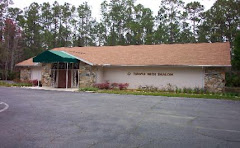
 Tu B’Shevat Plantings Yield Passover Fruit for Temple Students
Tu B’Shevat Plantings Yield Passover Fruit for Temple StudentsTu B’Shevat, the second full moon after the winter solstice during the third week in December marks the celebration in the Land of Israel of the produce of the trees and plants. In harmony with Israel, Jews throughout the world mark the occasion and celebrate by planting and eating of the produce of the Jewish National Homeland. At Palm Coast’s Temple Beth Shalom, young students planted as well, just as is done in Israel. This year’s crop included parsley plantings under the supervision of Educational Director Robyn Shapiro.
Students watched as the plants grew seed leaves and ultimately an ample crop under the ideal conditions of the grounds of the synagogue in Palm Coast. By Passover, the Festival of Freedom and the Holiday of Spring, the crops were ready for use as the traditional Karpas, or green vegetable used for dipping in salt water at the Seder meal on the first two nights of the eight day Feast.
Karpas is one of the traditional rituals in the Passover Seder. It refers to the vegetable, usually parsley or celery, that is dipped in liquid (usually salt water) and eaten. The liquid may be any of the seven which make food capable of becoming ritually impure, although salt-water or vinegar are usually used. The idea behind the salt water is to symbolize the salty tears that the Jews shed in their slavery in Egypt. The vegetables symbolize the coming of the spring.
Some have explained the dipping of the Karpas to symbolize the Biblical Joseph’s tunic being dipped into blood by his brothers. Karpas is therefore done at the beginning of the seder, just as Joseph's tunic being dipped into blood began, as the Book of Genesis describes, the Israelites descent to Egypt. Indeed, the word Karpas, in some languages, means cloth.
The educational technique connects students ever more closely to the most ancient of rituals, bringing to life in 21st century Palm Coast customs and ceremonies with 3000 year old roots in the biblical Middle East.

No comments:
Post a Comment